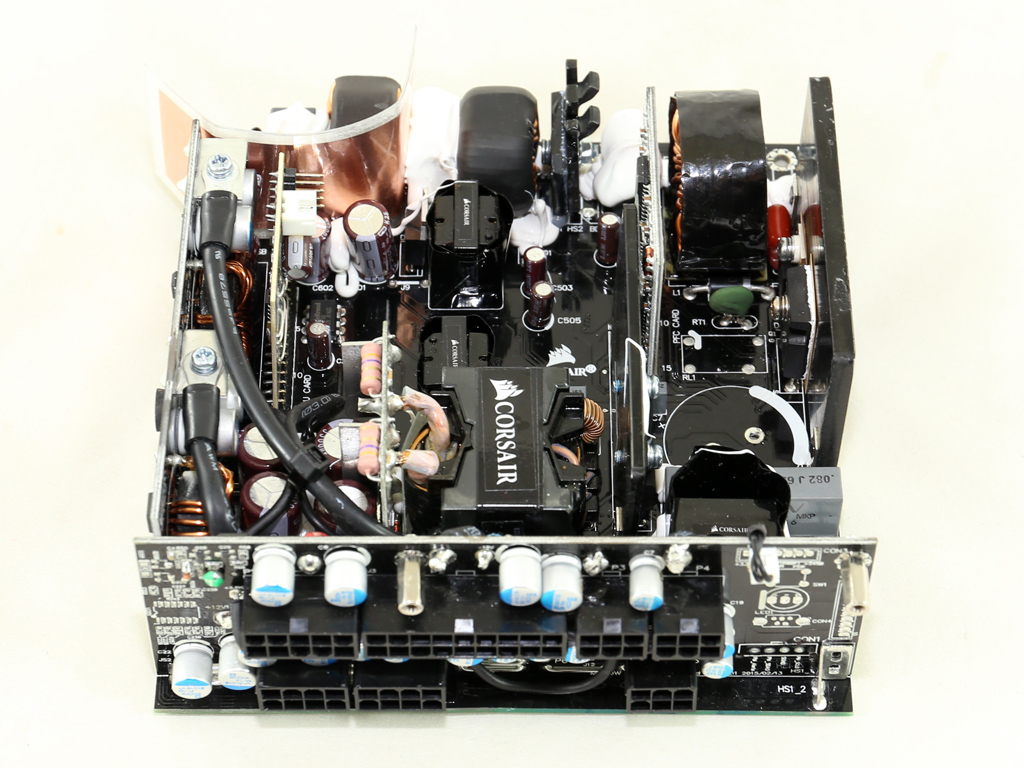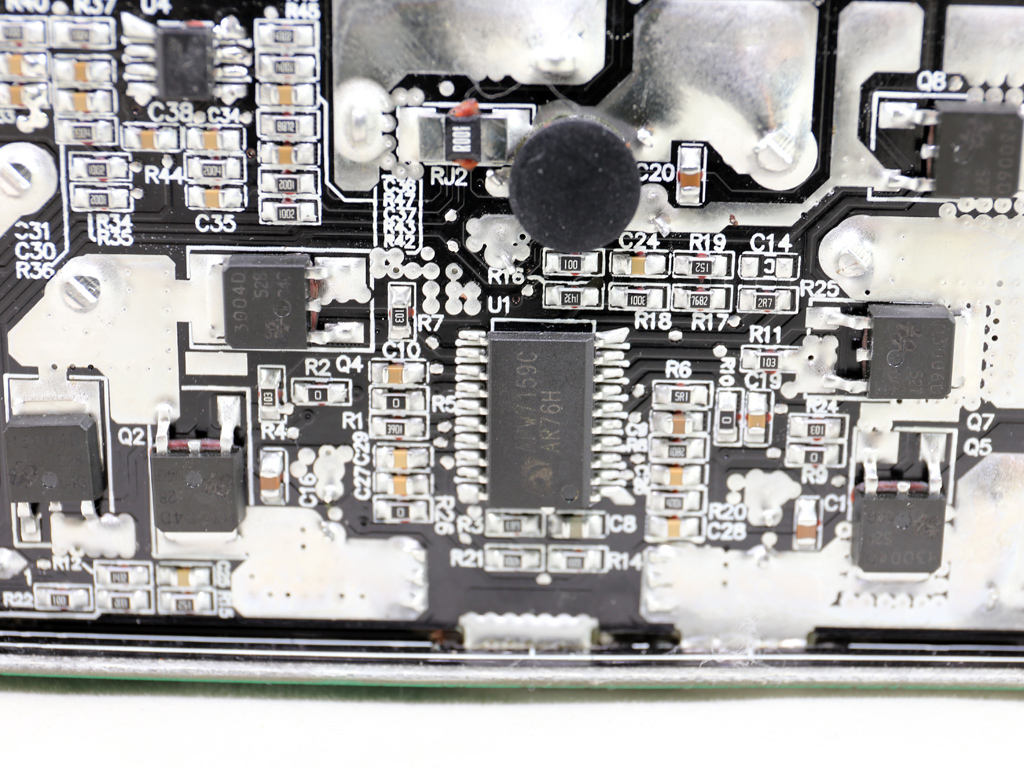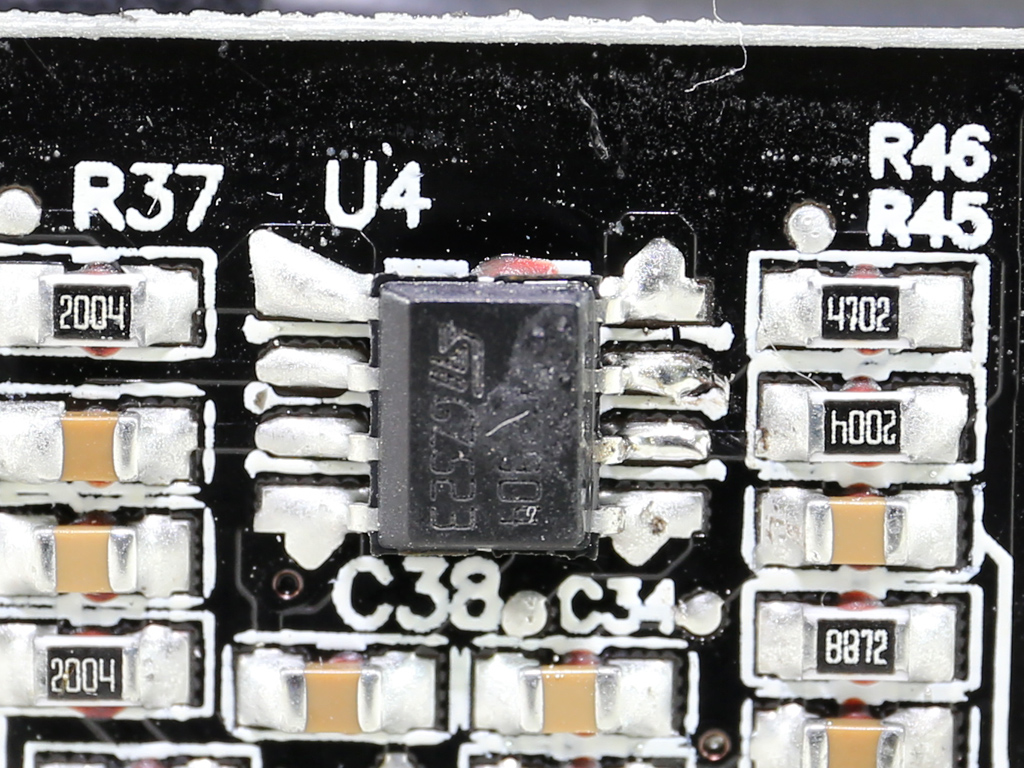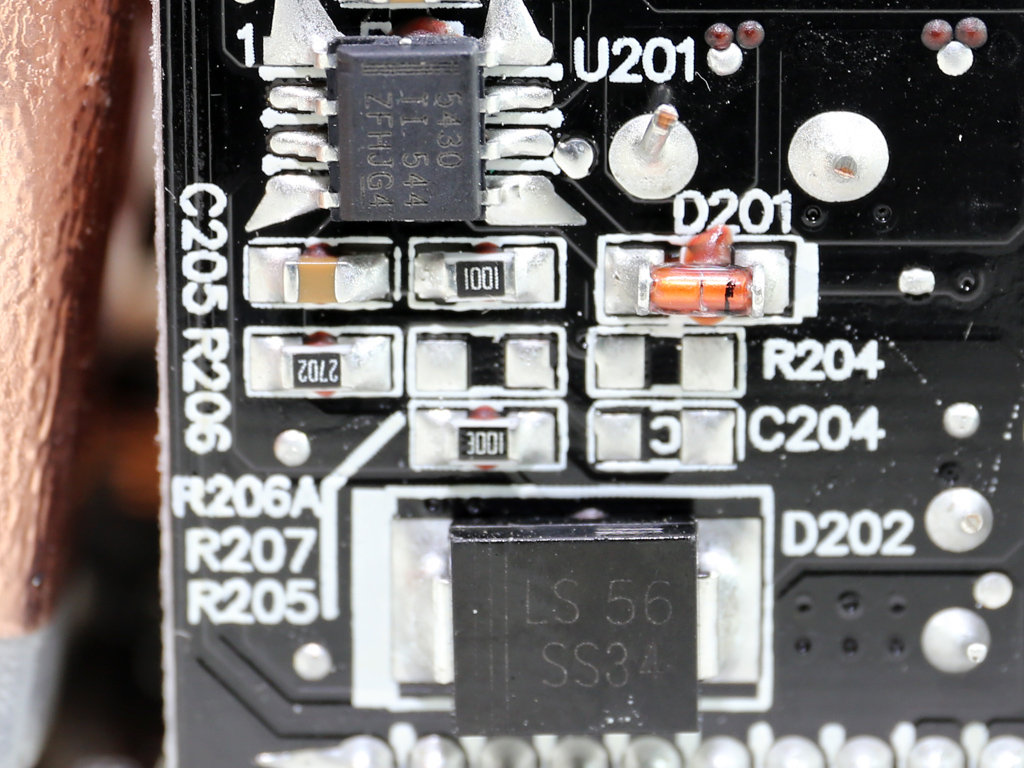Corsair RM550x Power Supply Review
The lowest-capacity unit Corsair's RMx line outputs up to 550W and is 80 PLUS Gold-certified. It features fully modular cabling, offers great performance and is nearly silent throughout its operating range, too.
Why you can trust Tom's Hardware
A Look Inside And Component Analysis
Parts Description
Before proceeding with this page, we strongly encourage you to a look at our PSUs 101 article, which provides valuable information about PSUs and their operation, allowing you to better understand the components we're about to discuss. Our main tools for disassembling PSUs are a Thermaltronics soldering and rework station, and a Hakko 808 desoldering gun.
| Primary Side | |
|---|---|
| Transient Filter | 4x Y caps, 2x X caps, 2x CM chokes, 1x MOV |
| Inrush Protection | NTC Thermistor |
| Bridge Rectifier | 1x GBU1506 (600V, 15A @ 100 °C) |
| APFC MOSFETs | 1x Vishay SIHG30N60E (650V, 18A @ 100 °C, 0.125 ohm) |
| APFC Boost Diode | 1x Panjit SiC04A065T (600V, 4A @ 150 °C) |
| Hold-up Cap | 1x Nippon Chemi-Con (400V, 470uF each, 2000h @ 105 °C, KMQ) |
| Main Switchers | 2x Infineon IPA50R280CE (550V, 4.7A @ 100 °C, 0.28 ohm) |
| APFC Controller | Infineon ICE3PCS01G - CM03X |
| Switching Controller | Infineon ICE2HS01G |
| Topology | Primary side: Half-Bridge & LLC Resonant Converter Secondary side: Synchronous Rectification & DC-DC converters |
| Secondary Side | |
| +12V MOSFETs | 4x Sinopower SM4021NAKP (40V, 100A @ 100 °C, 2.7 mohm @ VGS=6V) |
| 5V & 3.3V | DC-DC Converters: 2x M3006D & 4x M3004D FETs PWM Controller: APW7159 |
| Filtering Capacitors | Electrolytics: Chemi-Con (105 °C, KZE & KZH series) Polymers: Nippon Chemi-Con |
| Supervisor IC | Weltrend WT7502 (PG, *OVP, *UVP, *SCP) * for 5/3.3V only |
| Fan Model | NR135L (12V, 0.22A, Rifle Bearing) |
| 5VSB Circuit | |
| Rectifier | PFR20V45CT (45V, 20A, VF: 0.42V max @ 125 °C) |
| Standby PWM Controller | On-Bright OB5269 |





There are only three heat sinks: a very small one for the bridge rectifier and two thin ones without any fins. The first of those is for the APFC FET and diode, while the second is for the primary switchers. On the secondary side, the +12V FETs are cooled by the PCB that holds them and two metallic bars. The minor rails are generated by two DC-DC converters installed on a large vertical daughterboard.
Channel Well Technology (CWT) is the OEM that Corsair uses for its RM, RMi and RMx units. Inside, the RMx platform is similar to the RMi. Of course, there is no digital interface to facilitate monitoring and fan control. And although the RMi PSUs are equipped with a fluid dynamic bearing (FDB) fan, the RMx models use a lower-quality rifle bearing fan.




On the AC receptacle, two Y caps form the first part of the EMI filter. The latter continues on the main PCB with two more Y caps and two X ones, two CM chokes and an MOV. The EMI filter on the main PCB is protected by a copper shield to further suppress EMI noise. If this shield was grounded, it would definitely do a better job.


A small heat sink dissipates thermal energy from the single bridge rectifier, a GBU1506. This rectifier can handle up to 15A of current, so it covers the RM550x's needs.



The APFC converter uses a single Vishay SIHG30N60E FET and Panjit SiC04A065T boost diode. The bulk cap is by Chemi-Con (400V, 470uF, 2000h @ 105 °C, KMQ), and its capacity looks to be ideal for the RM550x. In front of the PFC, coil we find a small NTC thermistor that provides protection against large inrush currents. Although a bypass relay isn't used, we suspect that the diode right beside it somehow isolates it from the circuit once the PSU starts.


A small daughterboard houses the APFC controller, an Infineon ICE3PCS01G that's backed up by a CM03X Green PFC controller. On the same board, there's also an Infineon ICE2HS01G LLC resonant controller.
Get Tom's Hardware's best news and in-depth reviews, straight to your inbox.


A couple of Infineon IPA50R280CE FETs are the primary switchers; they're arranged into a half-bridge topology.
Here are the inductive and capacitive parts of the LLC resonant converter.




The lack of any heat sinks on the secondary side makes quite an impression. This might be an efficient Gold-rated power supply, but we still expected at least a small sink for the +12V FETs. CWT obviously had a different opinion, and Corsair must be very confident about its design or it wouldn't offer such a long warranty.
The FETs that generate the +12V rail are four Sinopower SM4021NAKPs, all installed on a small PCB. The board and two metallic bars help cool these FETs. We also noticed that two short, thick cables connect the main transformer's output with the +12V PCB, minimizing energy losses.


Four Chemi-Con electrolytic caps (rated at 105 °C) filter the +12V rail. All of the PSU's other filtering caps come from the same manufacturer.






The PCB shown in the photos above houses both DC-DC converters responsible for generating the minor rails. The common PWM controller is an Anpec APW7159. In total, two M3006D and four M3004D FETs are used.


The supervisor IC is a Weltrend WT7502 IC, which is installed on the main PCB. This IC provides only the very basic protections including OVP, UVP and SCP for the minor rails. More than likely, CWT uses another circuit to implement +12V protection features.
The 5VSB rail is regulated by a PFR20V45CT Schottky Barrier Diode (SBR) installed on the PCB's component side. The standby PWM controller (an On-Bright OB5269 IC) is installed on the solder side of the main PCB. Right next to it is a M03N65D FET; we don't know what purpose it serves.
The RMi family's MCU board is populated with a PIC32MX, which is the brains of the digital interface. That IC is missing in the RMx line-up. And because the cooling fan isn't PWM-controlled, its fan header only has two pins instead of four.







On the front side of the modular PCB, many Chemi-Con capacitors provide an extra layer of ripple suppression.



A number of cables on the back of the modular board transfer power. We also spotted a single M3004D FET back there.



Overall, the soldering quality is pretty good.






Here are some closer shots of the main PCB's solder side. We noticed two current shunt resistors under the +12V islands, suggesting that this platform can support OCP for at least two +12V rails with the proper supervisor IC. There is space on the modular PCB for two extra supervisor ICs, which you find installed on members of the RMi family.


Again, Corsair uses a rifle bearing fan on its RMx units in an effort to lower their prices. The NR135L (135mm, 12V, 0.22A) is a low-speed fan featuring quiet operation, even when it's spinning quickly.
Current page: A Look Inside And Component Analysis
Prev Page Packaging, Contents, Exterior And Cabling Next Page Load Regulation, Hold-Up Time And Inrush Current
Aris Mpitziopoulos is a contributing editor at Tom's Hardware, covering PSUs.
-
basroil From the performance it seems like CWT is finally something to consider... It's showing Leadex Gold/Seasonic levels of performance.Reply -
Dark Lord of Tech I love the RMX and RMI series , price just keeps me away from the purchase , very very solid.Reply
Knock a little off the price and these would fly out of warehouses. -
Dark Lord of Tech Yeah the 550w should be about 79.99 to 89.99 , no rebates.Reply
Then I would grab a few. -
JQB45 ReplyYeah the 550w should be about 79.99 to 89.99 , no rebates.
Then I would grab a few.
Corsair RMx 550W 80+ Gold Certified Fully-Modular ATX Power Supply
http://pcpartpicker.com/part/corsair-power-supply-cp9020090na
$79.99
$89.99 for the 650W version.
UPDATE:
Sorry thats with mail in rebates... -
Dark Lord of Tech I don't do rebates , takes to long , and maybe you get it maybe you don't , I'll wait for a newegg drop.Reply -
Nintendork We really need more platinum/titanium PSU's at 300-500w. Most PC's stays near idle and with the efficiency focused gpu's/cpu's they rarely exceed 100w unless you tax them.Reply -
turkey3_scratch Plus companies often don't even send you the rebates, sometimes they just say it was too late or some other bull crap like that. I agree with Blackbird. I've been waiting for a review of the 550 RMx, and what I get out of this review is that it trades blows with the 550 G2 that saying one or the other is better is just silly and extremely nit-picky. They are both incredible. Both offer a 7 year warranty, as only higher-wattage G2s offer the 10 year warranty. They are just so close, that when it comes to picking the better one, the cheaper one is better, and the G2 is cheaper.Reply
I've actually quit including rebates in my pcpartpicker lists. They are a pain and I don't think they reflect the true cost of an item. -
turkey3_scratch Reply17653281 said:We really need more platinum/titanium PSU's at 300-500w. Most PC's stays near idle and with the efficiency focused gpu's/cpu's they rarely exceed 100w unless you tax them.
I wish so, but unfortunately if this were to happen they would end up priced the same as any Platinnum/Titanium 650W unit. It's just the way it works. Quality low-wattage models are priced almost the same as the higher-wattage models. I would like to see something like a Titanium 250W model come out from Seasonic. Something like $40, fully modular. Will never happen, though.


